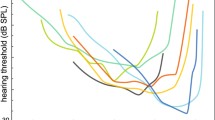Abstract
THE mammalian cochlea is generally considered to be a frequency analyser. When the ear is stimulated by a pure tone the basilar membrane vibrates. The amplitude of the vibrations varies along the length of the membrane with the position of the maximum depending in a graded way upon the frequency of the tone1,2. The basal turn responds maximally to high frequencies, the apex to low frequencies. Consequently hair cells situated along the membrane are frequency selective. The nerve fibres innervating the basilar membrane have low thresholds over a narrow range of frequencies corresponding to the displacement maxima of the section of the basilar membrane that they innervate3. But the neural tuning curves (the relationship between threshold and frequency for individual nerve fibres) are much sharper than the mechanical tuning curves of the basilar membrane (the relationship between amplitude of displacement and frequency at a single point on the membrane) and this discrepancy has led to the proposal of a “second filter”4. In this paper we describe the tuning of intracellularly recorded receptor potentials from histologically identified hair cells (IHC) of the guinea pig cochlea in an effort to investigate the nature of the hypothetical sharpening process and we conclude that IHCs are tuned as sharply as auditory nerve fibres. To our knowledge this is the first time intracellular recordings have been made from inner hair cells in the mammalian cochlea.
Similar content being viewed by others
References
Bekesy, G. von, Experiments in Hearing (McGraw-Hill, New York, 1964).
Johnstone, B. M. & Boyle, A. J. F., Science 158, 389–390 (1967).
Robertson, D. & Manley, G. A., J. comp. Physiol. 91, 363–375 (1974).
Evans, E. F., J. Physiol., Lond. 226, 263–287 (1972).
Brown, K. T. & Flaming, D. D., Brain Res. 86, 172–180 (1975).
Robertson, D., Science 186, 135–155 (1974).
Harris, G. G., Frischkopf, L. S. & Flock, A., Science 167, 76–79 (1970).
Mulroy, M. J., Altmann, D. W., Weiss, T. F. & Peake, W. T., Nature 249, 482–485 (1974).
Eccles, J. C., The Physiology of Synapses (Academic, New York, 1964).
Author information
Authors and Affiliations
Rights and permissions
About this article
Cite this article
RUSSELL, I., SELLICK, P. Tuning properties of cochlear hair cells. Nature 267, 858–860 (1977). https://doi.org/10.1038/267858a0
Received:
Accepted:
Published:
Issue Date:
DOI: https://doi.org/10.1038/267858a0
- Springer Nature Limited
This article is cited by
-
Prestin-Mediated Frequency Selectivity Does not Cover Ultrahigh Frequencies in Mice
Neuroscience Bulletin (2022)





